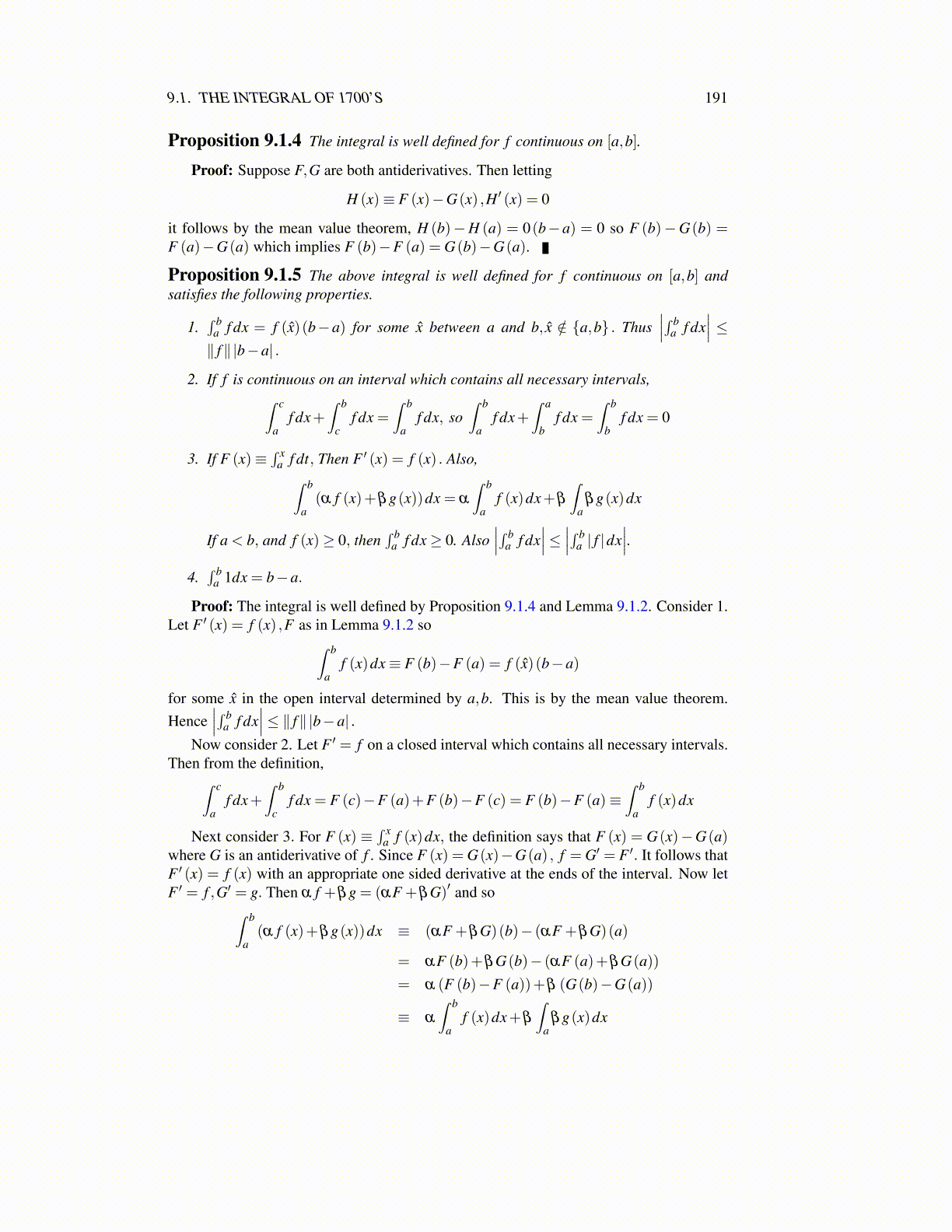
9.1. THE INTEGRAL OF 1700’S 191
Does this give the main properties of the integral? In particular, is the integral still linear?Suppose f ,g are piecewise continuous. Then let {zi}n
i=1 include all the partition points ofboth of these functions. Then, since it was just shown that no harm is done by includingmore partition points,
∫ ba α f (t)+βg(t)dt ≡
n
∑i=1
∫ zi
zi−1
(α fi (s)+βgi (s))ds =n
∑i=1
α
∫ zi
zi−1
fi (s)ds+n
∑i=1
β
∫ zi
zi−1
gi (s)ds
= α
n
∑i=1
∫ zi
zi−1
fi (s)ds+β
n
∑i=1
∫ zi
zi−1
gi (s)ds = α
∫ b
af (t)dt +β
∫ b
ag(t)dt
Also, the claim that∫ b
a f dt =∫ c
a f dt +∫ b
c f dt is obtained exactly as before by consideringall partition points on each integral preserving the order of the limits in the small intervalsdetermined by the partition points. That is, if a > c, you would have zi−1 > zi in computing∫ c
a f dt.
Definition 9.1.8 Let I be an interval. Then XI (t) is 1 if t ∈ I and 0 if t /∈ I.Then a step function will be of the form ∑
nk=1 ckXIk (t) where Ik = [ak−1,ak] is an inter-
val and {Ik}nk=1 are non-overlapping intervals whose union is an interval [a,b] so b−a =
∑nk=1 (ak−ak−1). Then, as explained above,∫ b
a
n
∑k=1
ckXIk (t)dt =n
∑k=1
ck
∫ ak
ak−1
1dt =n
∑k=1
ck (ak−ak−1) .
The main assertion of the above Proposition 9.1.5 is that for any f continuous, thereexists a unique solution to the initial value problem F ′ (t) = f (t) , along with F (a) = 0 andit is F (t) =
∫ ta f (x)dx. As an example of something which satisfies this initial value prob-
lem consider A(x) the area under the graph of a curve y = f (x) as shown in the followingpicture between a and x.
aA(x)
y = f (x)
x x+h
A(x+h)−A(x)
Thus A(x+h)−A(x) ∈ [ f (x)h, f (x+h)h] and so
A(x+h)−A(x)h
∈ [ f (x) , f (x+h)] .
Then taking a limit as h→ 0, one obtains A′ (x) = f (x) ,A(a) = 0 and so one would haveA(x) =
∫ xa f (t)dt. Other situations for the graph of y = f (x) are similar. This suggests that
we should define the area under the graph of the curve between a and x > a as this integral.Is this as general as a complete treatment of Riemann integration? No it is not. In
particular, it does not include the well known example where f (x) = sin( 1
x
)for x ∈ (0,1]
and f (0)≡ 0. However, it is sufficiently general to include all cases which are typically ofinterest starting with Dirichlet and his consideration of convergence of Fourier series. It isalso enough to build a theory of ordinary differential equations and do all standard examplesof beginning calculus. However, this integral, as well as the more general Riemann integraldiscussed below are woefully inadequate when it comes to a need to handle limits. Youneed the Lebesgue integral or something more sophisticated to obtain this. Such integralsare considered later.